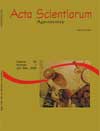<b>Caracterização da fenologia e exigência térmica (graus-dias) para a uva 'Cabernet Sauvignon' em zona subtropical</b> - DOI: 10.4025/actasciagron.v27i1.2144
Resumo
O trabalho teve como objetivo caracterizar o comportamento fenológico da videira 'Cabernet Sauvignon' (Vitis vinifera L.) cultivada no noroeste do Estado do Paraná, bem como caracterizar sua exigência térmica em graus-dias. A área experimental foi instalada em uma propriedade comercial pertencente à Vinícola Intervin®, localizada no município de Maringá, Estado do Paraná. O vinhedo foi estabelecido em agosto de 2000 e as plantas foram conduzidas no sistema latada no espaçamento de 4,0 m x 1,5 m. As avaliações tiveram início a partir da poda de produção, realizada no fim do inverno de 2003. O delineamento experimental foi inteiramente casualizado com 20 repetições, sendo cada unidade experimental constituída por uma única planta. A fenologia das plantas foi avaliada quanto à duração em dias de cada um dos seguintes subperíodos: poda à gema-algodão; poda à brotação; poda ao aparecimento da inflorescência; poda ao florescimento; poda ao início da maturação das bagas e poda à colheita. A exigência térmica da uva 'Cabernet Sauvignon' foi calculada empregando-se o somatório de graus-dia desde a poda até a colheita, bem como para cada um dos subperíodos, considerando-se duas temperaturas-base (10ºC e 12ºC). Pelos resultados obtidos concluiu-se que: a duração do ciclo da poda à colheita da videira 'Cabernet Sauvignon' no noroeste do Paraná é de 126 dias e a sua exigência térmica é de 1.221,25 graus-dias, sendo a temperatura-base de 10ºC a mais adequada para o cálculo desta demanda.Downloads
DECLARAÇÃO DE ORIGINALIDADE E DIREITOS AUTORAIS
Declaro que o presente artigo é original, não tendo sido submetido à publicação em qualquer outro periódico nacional ou internacional, quer seja em parte ou em sua totalidade.
Os direitos autorais pertencem exclusivamente aos autores. Os direitos de licenciamento utilizados pelo periódico é a licença Creative Commons Attribution 4.0 (CC BY 4.0): são permitidos o compartilhamento (cópia e distribuição do material em qualqer meio ou formato) e adaptação (remix, transformação e criação de material a partir do conteúdo assim licenciado para quaisquer fins, inclusive comerciais.
Recomenda-se a leitura desse link para maiores informações sobre o tema: fornecimento de créditos e referências de forma correta, entre outros detalhes cruciais para uso adequado do material licenciado.




















































